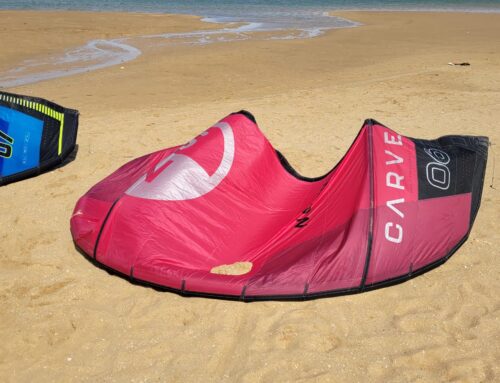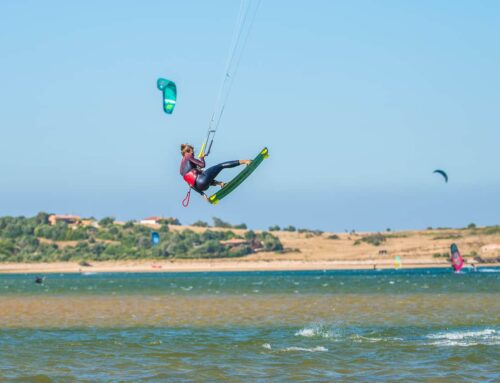
Kitesurfing vs Windsurfing: A Comprehensive Guide
Kitesurfing and windsurfing are two of the most popular water sports in the world. Both sports involve harnessing the power of the wind to glide across the water, but they differ in many ways.
In this article, we will compare and contrast kitesurfing vs windsurfing, highlighting the pros and cons of each sport.
What is Kitesurfing?
Kitesurfing is an exciting water sport that’s been catching waves of popularity. It’s all about tapping into the wind’s power with a kite to glide across the water on a board. This sport is known for its thrill and requires a mix of skill and knowledge about the wind to really make the most of it. Riders can fly high, pulling off bold jumps, and showing cool tricks, making it a bit more adventurous than windsurfing.
What is Windsurfing?
Windsurfing, on the other hand, is a more established sport that has been around since the 1960s. Mixing sailing and surfing, it became very popular in the 80s and 90s, becoming a part of international competitions and securing its position as one of the most accessible watersports throughout the years.
Windsurfing involves using a sail attached to a board to catch the wind and propel the rider across the water’s surface.
Windsurfing is a technical sport that requires balance, coordination, and a good understanding of wind and water conditions. It is sometimes considered more accessible than kitesurfing, as it is easier to get up and going and requires less wind to make first rides on the board with the sail.
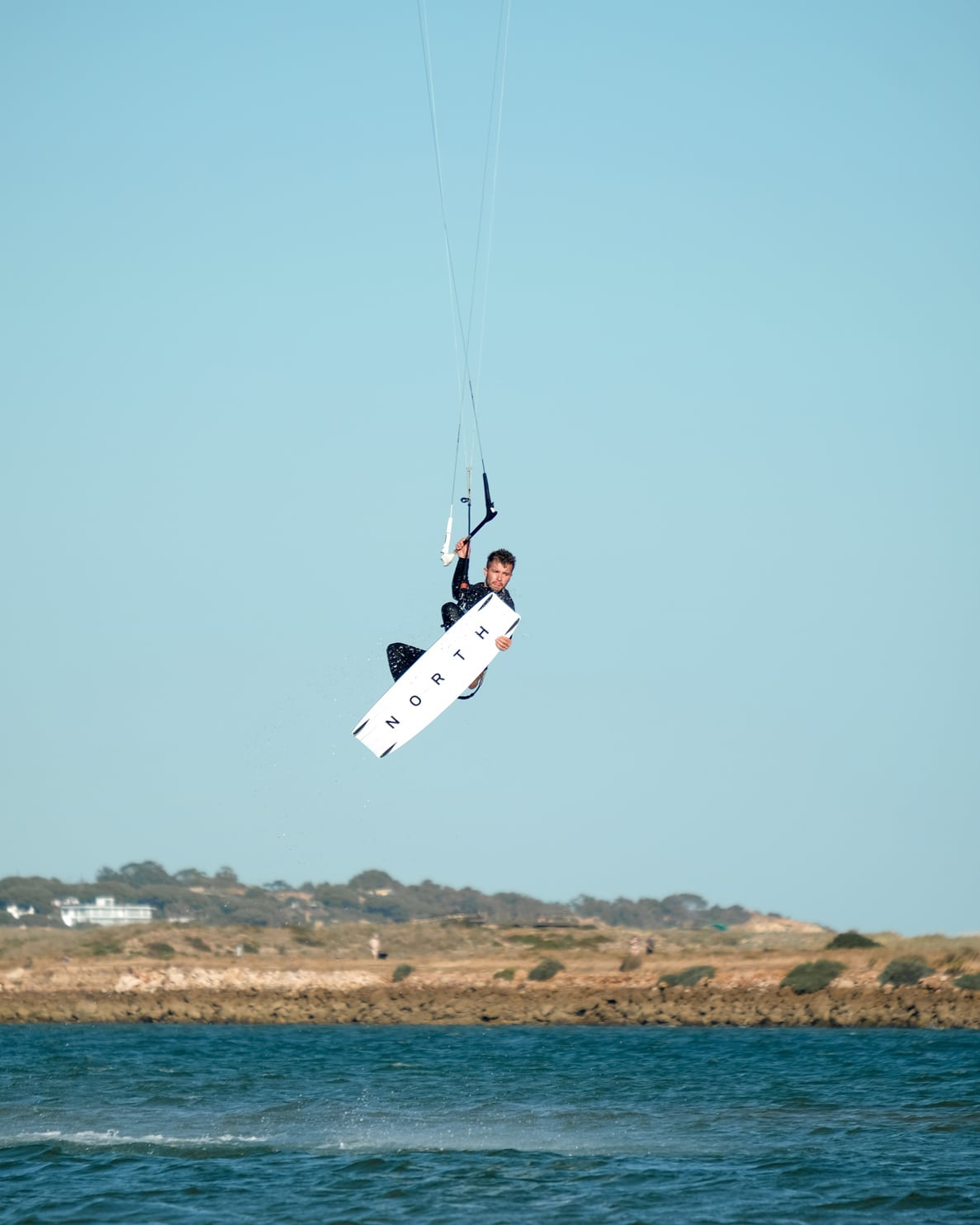
Fundamentals of Kitesurfing and Windsurfing
Equipment and Gear
Both kitesurfing and windsurfing require specific equipment and gear.
For kitesurfing, the most essential piece of equipment is the kite, which is attached to the rider via a harness. The kite is controlled by a bar with lines that the rider uses to steer the kite and control its power.
In addition to the kite, kitesurfers also need a board, which is similar to a wakeboard, and a wetsuit to protect them from the water and wind.
For windsurfing, the board is the most important piece of equipment. The board has a sail attached to a mast, which is controlled by the rider using a boom.
The rider stands on the board and uses their body weight to control the board’s direction and speed. In addition to the board and sail, windsurfers also need a wetsuit and a harness to attach themselves to the sail.
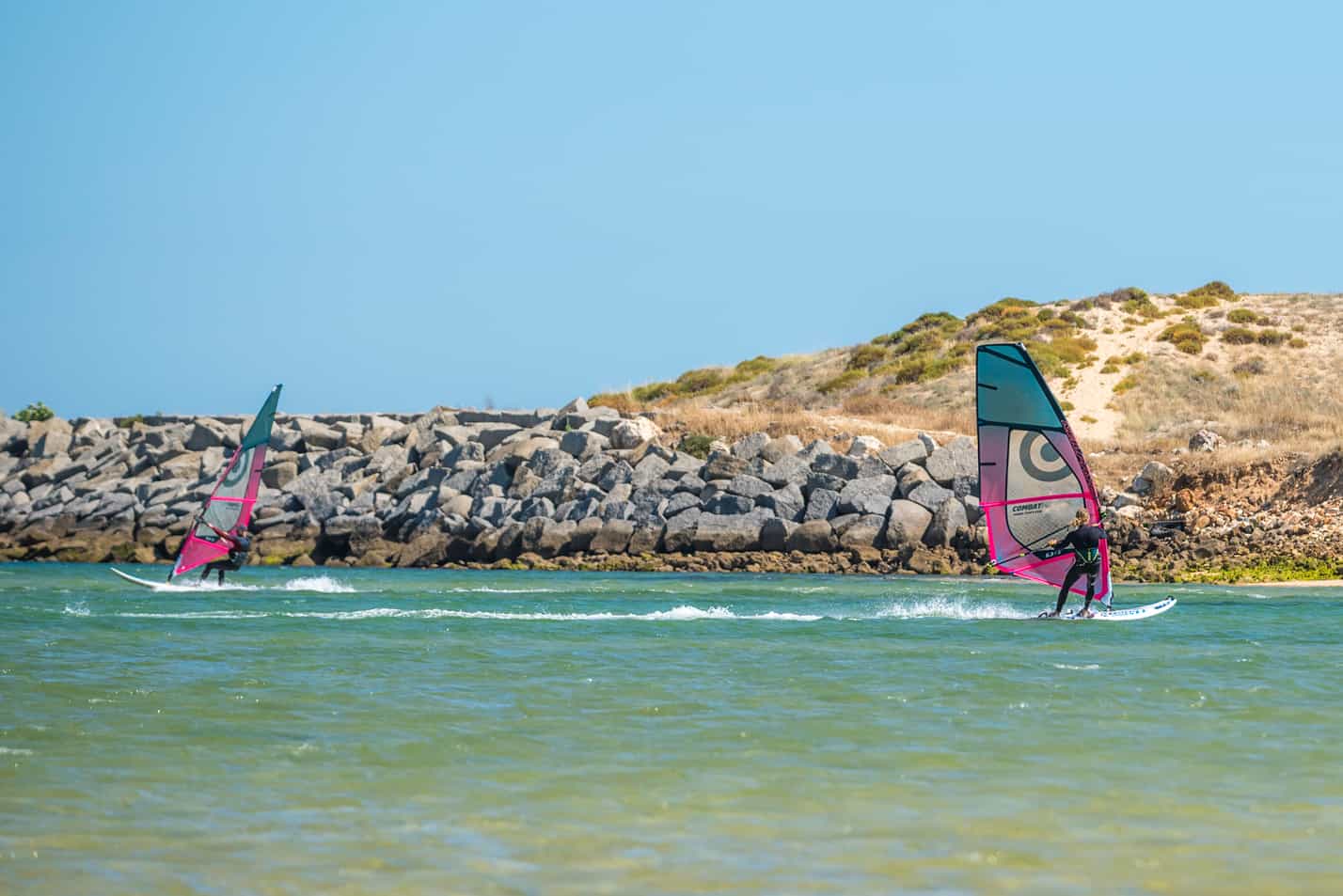
Learning Curve and Skill Development
Both kitesurfing and windsurfing require a certain level of skill and practice to master.
Kitesurfing can be easier to learn for some people because it requires less physical strength to control and generate power from the kite.
The initial challenge is learning to control the power of the kite, which, although it might seem complex initially, can be mastered with consistent practice and effective instruction. This learning curve allows beginners to quickly reach a stage where they can enjoy their first rides on the board and even first jumps, sometimes within just a few sessions.
However, since the sport requires more wind, it can introduce an element of intensity and perceived risk that isn’t as pronounced in windsurfing. Before taking the board, learners need to dedicate time to kite control and safety practices. This foundational phase is critical to pave the way for a safe and more confident entry into the sport.
Windsurfing, by contrast, can seem more physically challenging due to the need for greater strength and balance, especially when managing the sail in the early stages of learning. However, its advantage lies in the lower wind requirements, making the early stages more accessible and less intimidating for newcomers. Students often find themselves sailing solo on day one, quickly feeling the wind’s pull on the sail.
However, as one progresses in windsurfing, the learning curve steepens. Advancing to more advanced techniques, like planning or executing jumps, requires dedicated effort and practice.
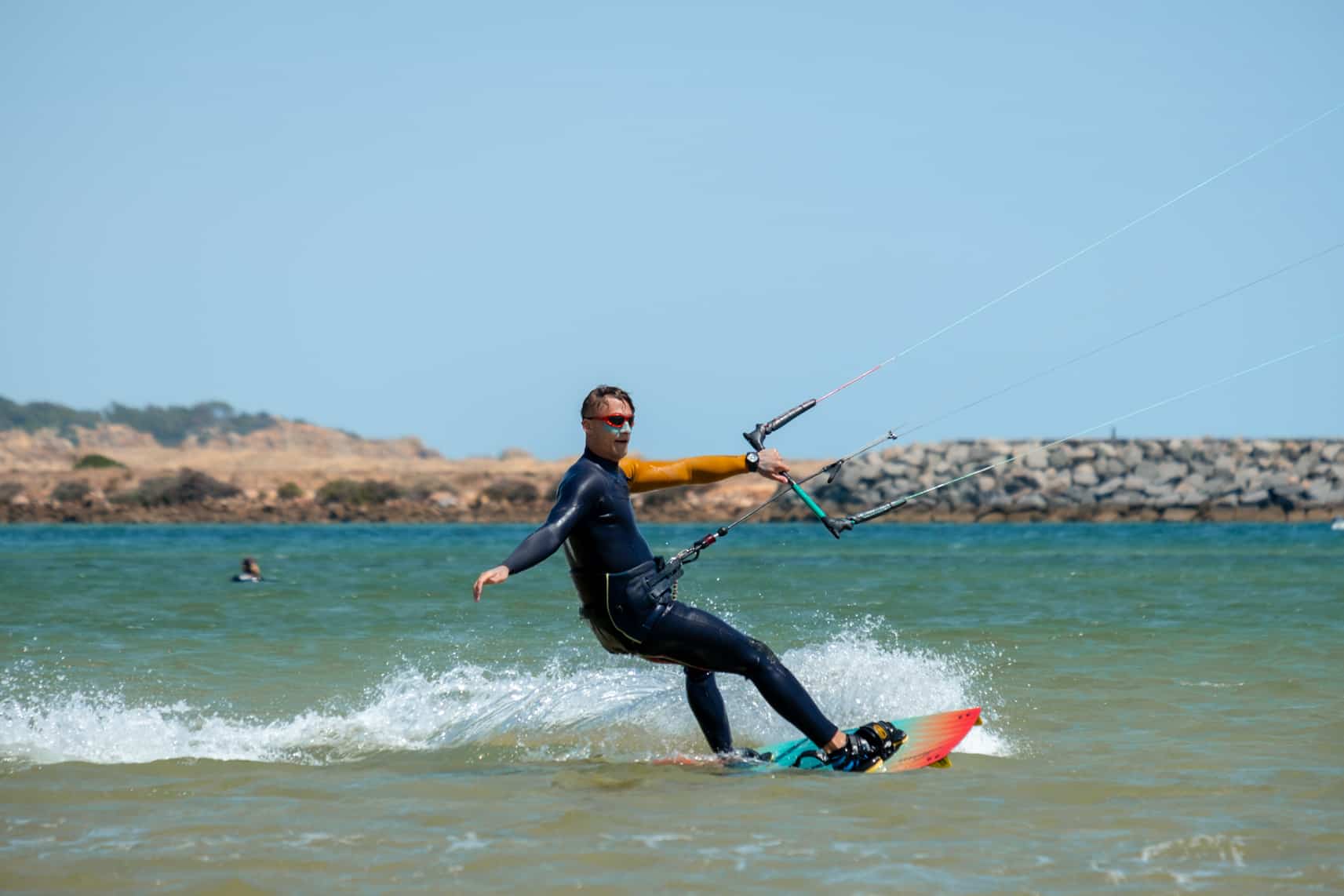
Typical Environments
Kitesurfing and windsurfing are popular in coastal areas with consistent wind and waves. Kitesurfing is often done in open waters and waves or big areas with flat water like open lagoons or bays. Windsurfing, in contrast, isn’t limited to the sea; it thrives in any body of water, from lakes to sheltered bays, as long as the wind is blowing.
When it comes to wind conditions, each sport has its sweet spot. Kitesurfing usually requires a breeze of at least 12-15 knots to truly come alive and offer the full thrill of the sport, whereas windsurfing can delight its enthusiasts with lighter winds, starting around 10 knots. This slight difference highlights the accessibility of windsurfing to beginners eager to get on the water sooner.
The experience of either sport can significantly depend on the wind’s consistency. For beginners in windsurfing, even gusty conditions can be manageable and part of the learning journey. In kitesurfing, however, the stability of the kite and the progression of the learning process can be greatly influenced by gusty winds. In both sports, assessing the wind conditions and ensuring the safety of the chosen spot are crucial considerations that determine the quality of the experience.
Comparative Analysis
Speed and Performance
When comparing the dynamics of speed and performance, kitesurfing and windsurfing each present unique strengths. Windsurfing is often regarded as the faster discipline, thanks to the efficient way in which sailors can harness wind power with their sails. This efficiency shines when tackling upwind or crosswind courses, enabling windsurfers to reach speeds that kitesurfers might find challenging to match.
Kitesurfing, on the other hand, excels in its versatility and freedom, opening up a realm of creative possibilities or different riding styles and tricks. Among kitesurfing’s standout features is the thrill of jumping, which is accessible even to riders of a semi-intermediate skill level. Unlike windsurfing, where high jumps usually require the assistance of waves and a higher degree of proficiency, kitesurfing participants can achieve significant aerial heights in various water conditions, providing a unique sense of flight that many find addictive.
Physical Demands and Fitness
Both kitesurfing and windsurfing require a certain level of fitness and physical ability. In kitesurfing, the emphasis is less on raw upper body strength and more on the ability to harness and coordinate the kite’s power.
Windsurfing, by contrast, challenges participants with more physical demands, including substantial upper body strength for sail control, as well as leg strength and core endurance to steer the board.
Regardless of these distinctions, both sports offer an excellent form of physical exercise, engaging different muscle groups and providing a full-body workout. As such, whether you’re drawn to the graceful control of kitesurfing or the robust challenge of windsurfing, embracing either sport can lead to impressive physical and mental benefits.
Popularity and Culture
Kitesurfing has grown in popularity in recent years, particularly among younger riders. It’s seen as cool and extreme, perfect for those who love a bit of adventure – many kitesurfing towns across the World embrace the culture and lifestyle associated with the sport creating vibrant communities around the sport.
Windsurfing, however, has been enjoyed for many years and has a different vibe. It’s considered a calmer, more traditional water sport, with a close-knit community that appreciates a slower pace.
Safety Considerations
Kitesurfing and windsurfing are loads of fun but they’re not without their risks, which means you’ve got to be smart about safety. In kitesurfing, not knowing what you’re doing or facing off with really strong winds can lead to trouble fast. The kite can whip up a ton of force, and if it yanks you unexpectedly, you could find yourself in a dangerous spot real quick.
Similarly, windsurfing can be tricky, especially if you’re not yet comfortable with the equipment or the wind won’t stay steady. Unlike kitesurfing, you won’t get lifted into the air, but a sudden gust can still send you flying off the board in what’s known as a “catapult,” which is neither pleasant nor safe.
No matter your sport, wearing the right safety equipment is a must. Helmets, life jackets, and knowing what to do in case things go wrong are all part of staying safe while you enjoy the water.
Traveling
When it comes to hitting the waves, both kitesurfing and windsurfing offer exhilarating experiences, but the journey from home to the spot is quite different. Kitesurfing is often celebrated for its travel-friendly gear. Compact, lightweight kite bag over your shoulder, board in hand, and you’re off—whether it’s a quick bike ride or a hop on public transport, getting to your destination is a breeze.
Windsurfing, while equally thrilling on the water, presents a contrasting scenario regarding mobility and travel. With its larger size and heavier build, the windsurfing board requires more effort to transport, often needing a car.
For enthusiasts of kitesurfing or windsurfing, finding the ideal location for a vacation by the sea means paying attention to a few important details. You need to check the wind conditions at the destination and also consider the travel logistics and costs. Often, renting equipment right at the spot can save you the hassle of transporting bulky gear and dealing with airline baggage limits.
Ultimately, deciding between kitesurfing and windsurfing boils down to your own tastes and how good you are at each sport. Each offers its own set of thrills and benefits, welcoming enthusiasts from beginners to pros, and from the young to the young at heart.
If you are interested in learning to kitesurf or windsurf, check out our Kitesurf Camp or our Windsurf Camp

